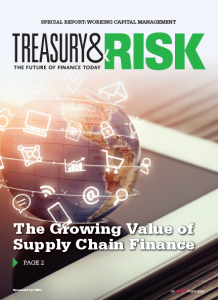It's 2019—do know where your company's cash is?
That question has been top-of-mind for treasurers lately, as global trade battles and economic indicators have begun to remind many of 2008. At the start of the Great Recession, some of the world's biggest and brightest companies could not satisfactorily answer crucial questions about their projected cash flows, and some businesses today find themselves in a similar situation. "We are seeing trade put a strain on working capital," notes EY Americas supply chain transformation and global supply chain RPA leader Sean Harapko.
Fortunately, supply chain finance (SCF) has steadily evolved over the past decade, and today it stands poised to help support businesses whose cash flows suddenly seem uncertain. The changes to SCF, which have largely been technology-driven, equip a broader collection of buyers and suppliers with tools they can use to optimize their cash position. At the same time, they give treasury greater transparency and certainty regarding accounts payable (A/P) and accounts receivable (A/R). Supply chain finance advancements are especially welcome in companies that may soon need to restructure supply chains to avoid the sting of tariffs.
 As the global business climate becomes more challenging, treasury leaders should understand what supply chain finance is and how it is evolving, the type of internal cooperation needed to support an SCF program, and key considerations and challenges that require attention when deploying SCF solutions. The treasurers who get the most value from supply chain finance tend to "get pretty creative with regard to how they leverage their access to cash to generate a better return on it," says C2FO managing director, working capital advisory, Sean Van Gundy.
As the global business climate becomes more challenging, treasury leaders should understand what supply chain finance is and how it is evolving, the type of internal cooperation needed to support an SCF program, and key considerations and challenges that require attention when deploying SCF solutions. The treasurers who get the most value from supply chain finance tend to "get pretty creative with regard to how they leverage their access to cash to generate a better return on it," says C2FO managing director, working capital advisory, Sean Van Gundy.
More Transparent, Collaborative, and Proactive
While supply chain finance has existed for decades, its current practice reflects the continuation of a trend that began several years ago. Most SCF solutions now revolve around a technology platform, and definitions of "supply chain finance" typically include terms like "transparent," "collaborative," "proactive," "optimize," and "marketplace." Van Gundy's company, which bills itself as the world's first and largest market for working capital, operates an online system designed to "create a seamless match" between A/R and A/P.
"Historically, supply chain finance was dominated by large banks, but now we're seeing financial technology [fintech] companies emerge to challenge these banks," Harapko explains. "There's also been a shift in terms of industry. Originally, supply chain finance was more supply chain focused but it has now started to be extended to all supplier types, including long-excluded categories like logistics and media."
Strategic Treasurer managing partner Craig Jeffery cites the Euro Banking Association's definition of supply chain finance: "the use of financial instruments, practices, and technologies to optimize the management of the working capital and liquidity tied up in supply chain processes for collaborating with business partners." These credit-extending mechanisms may include reverse factoring, dynamic discounting, blends of those instruments, factoring, invoice discounting, inventory finance, and related techniques. Strategic Treasurer distinguishes between buyer-led approaches, such as factoring and dynamic discounting, and supplier-led approaches like reverse factoring and invoice discounting.
Although some treasury experts include trade finance approaches, such as asset-based lending and bank payment obligations, in their definition of "supply chain finance," others argue that those traditional mechanisms should not be considered SCF activities. Van Gundy opts for a straightforward definition, describing supply chain finance as "providing liquidity at the point in the supply chain where it's needed."
The definition may be open to debate, but SCF's benefits tend to generate agreement among the experts: Suppliers get paid earlier by leveraging the value of a buyer's stout credit rating. As a result, suppliers are "able to monetize the supply chain better," explains Sankar Krishnan, Capgemini executive vice president, banking and capital markets. "The buyer gets a better, more consistent delivery of product or service, since the buyer can rely on the supplier to focus on the quality of the product as opposed to financial worries and risk."
Supply chain finance helps both parties forecast more effectively and increase cash flows. Most SCF technologies also include automation that reduces errors and removes manual steps from processes, resulting in efficiency gains for both parties, notes Jeffery. These improvements can strengthen buyer-seller relationships, he says.
Buyers and suppliers can leverage SCF to "make better decisions during the negotiation, as opposed to trying to address important terms later, which is usually very difficult to do," says Van Gundy. "It's not just about me trying to extend payment terms, as the buyer, or trying to get paid as quickly as possible, as the supplier. It's much more of a collaboration between the buyer and supplier, even in the negotiation of what the price means."
Treasury Leading the Way
Van Gundy observes that some treasury executives are leveraging supply chain finance to get more involved in day-to-day business decision-making. "I see more treasury functions operating a bit more like the CFO's office," he reports. "They are getting more strategic in nature and less reactive by forecasting the future needs of the company and then taking actions to have the cash and related structures in place to help enable those needs and objectives."
Playing a pivotal role in supply chain finance activities can also benefit treasury team members' careers. "Treasury is front-and-center to the success of a supply chain financing program, given their knowledge of cash flows, risk, credit, pricing, and the cost of money," Krishnan notes.
Treasury's responsibilities in an SCF deployment generally include communicating with and coordinating among all the affected functions, such as procurement, supply chain and logistics, legal and compliance, tax, A/P, A/R, and IT. Given its ownership of supplier relationships, the procurement function usually plays a significant role in determining whether and how the company will apply supply chain finance mechanisms. "If procurement says 'no,' it becomes very difficult to get the go-ahead," Van Gundy says.
In its "2018 Supply Chain Finance Analyst Report," Strategic Treasurer reported that 18 percent of companies operate a working capital council that is spearheaded by treasury and that consists of representatives from procurement, legal/tax, A/P, A/R, and accounting. The primary purpose of this committee is to clarify each group's unique responsibilities, benefits, and concerns related to working capital management, including supply chain finance.
Regardless of whether treasurers lead an internal working capital council, they can coordinate SCF activities among their organization's various functions and groups by laying out a list of questions the company should assess before implementing or improving supply chain finance capabilities. Jeffery suggests including the following financial and operational considerations:
- How will this help our financial metrics and flexibility?
- How can we do this without harming our trading partners?
- How can we do this to help our trading partners?
- What benefits will the power of the supply chain finance provider's network bring us (e.g., reach with partners, access to more capital)?
- How will it help improve the operational flow of information and smooth out processes?
- In particular, how can it help reduce exception processes and support self-service?
Five SCF Hurdles to Clear
Once treasury teams decide to implement or significantly enhance an SCF program, they should assess the challenges that they are likely to encounter. Supplier participation marks one of the most pervasive obstacles.
"Most organizations are pretty good about focusing on the largest partners, but can trail off as the direct return by supplier decreases," Jeffery notes. "The broader and more complete the reach [of the program], the better capital flexibility and process efficiency are achieved."
Treasury teams should recognize and be prepared to address the following five SCF implementation challenges:
1. Strategic shortcomings. Van Gundy encourages treasury executives to develop a comprehensive supply chain finance strategy before considering a new SCF investment. "Step back and look at it from a broader point of view, so that you can then go out and get the tools that help you achieve your goals within your strategy, not the other way around," he says. "Tools don't drive strategy; strategy drives tools."
When developing an SCF strategy, Harapko says, treasury teams can begin identifying and agreeing why they want such a plan, "whether it's to support financially weak suppliers or implement strategic initiatives." He also stresses that it is "imperative" that all solutions—from both traditional banks and fintech companies—are "thoroughly considered before implementation."
2. Lack of market knowledge. Van Gundy emphasizes that any SCF partners—whether banks or fintech companies—"must be able to service your markets." For example, if a buyer has suppliers in China, its SCF provider should understand how likely those suppliers are to participate in SCF marketplaces, compared with suppliers in other regions. Prospective SCF providers should also understand the magnitude of discounts that suppliers in China tend to offer to achieve more favorable payment terms (discounts are often quite high).
Van Gundy suggests that a treasury leader should ask potential SCF partners to describe their geographic footprints in all the markets in which the treasurer's company operates.
3. Communication breakdowns. Supply chain finance mechanisms involve multilateral communications efforts. Suppliers need to clearly understand the rationale of their buyer's new SCF program as well as the specific benefits they will gain from participating. Internally, ineffective communications among different functions within the buyer can prevent a new SCF program from getting off the ground. Treasurers focus on the liquidity management benefits of a potential SCF initiative, but those advantages do not resonate with A/P. Instead, their payables counterparts will want to understand how the investment might extend payment terms and/or improve supplier relationships.
Following any implementation or enhancement, project managers will need to continue communicating the results of the SCF activities. Benefits as well as new opportunities—from process, financing, and partner-relationship perspectives—should be tracked and reported throughout the organization, Jeffery notes.
4. Technology tangles. Supply chain finance solutions sit between, and exchange data with, large internal information systems (treasury management systems and enterprise resource planning systems, in particular). They also must connect with the systems of third parties, such as banks and other external partners. The integration between SCF applications, or portals, and all these other systems is critical. Van Gundy, who implemented supply chain finance solutions at major companies before joining C2FO, notes that buyers with a complex IT infrastructure tend to underestimate the amount of integration work that deploying SCF will require.
5. On-boarding friction. Suppliers are less likely to participate in an SCF program if they perceive the cost and effort of participation to be burdensome. "The pricing has to be attractive to the supplier, or no one is going to participate," Van Gundy asserts, "which means that the buyer is going to get very little value from it."
By proactively laying out the program's cost reductions (e.g., reduced float) and efficiency gains (e.g., less manual processing, faster exception handling), buyers are more likely to secure buy-in among their suppliers, according to the Strategic Treasurer analyst report. That study also recommends ensuring that suppliers have convenient access to training and support related to the use of newly implemented SCF technology solutions.
Given the obstacles to implementation of SCF, treasury leaders need to manage expectations around their supply chain finance investments. Van Gundy acknowledges that SCF providers tend to sell an optimistic vision of the future. He encourages treasury leaders to adjust that vision to reflect their organization's reality. "If a provider tells me that 70 percent of the supply base is going to have to participate, would I be happy with 35 percent participating?" he hypothesizes. "If so, that's a pretty good business case."
Treasury teams also need to focus on the relevancy of expectations as they dial in their projected future vision. If a buyer's primary SCF objective is to improve working capital management, then its overall determinant of the success of the program should not revolve around the proportion of suppliers that participate in the program.
"You don't want to say, 'Well, we weren't successful in supply chain finance because we only had 3 percent of our supply base participate in the program,'" Van Gundy says. "If the top 3 percent of suppliers gave you the terms you requested to generate the working capital you wanted, you succeeded. … Ultimately, it's the responsibility of the folks providing the supply chain finance tools to get suppliers to see the value and to participate."
Also from the September 2019 Special Report:
Recommended For You
Sponsored Statement—C2FO: The 3 Hidden Truths to Effective Working Capital Management
View the Digital Edition Here: The Growing Value of Supply Chain Finance
Eric Krell's work has appeared previously in Treasury & Risk, as well as Consulting Magazine. He is based in Austin, TX.
© 2025 ALM Global, LLC, All Rights Reserved. Request academic re-use from www.copyright.com. All other uses, submit a request to [email protected]. For more information visit Asset & Logo Licensing.







